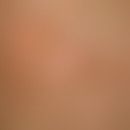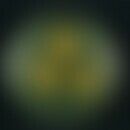Synonym(s)
HistoryThis section has been translated automatically.
DefinitionThis section has been translated automatically.
Inflammatory spotty pigmentation on the face, which is seen as a variant of melanodermatitis toxica.
You might also be interested in
EtiopathogenesisThis section has been translated automatically.
Unexplained, probably photosensitization of previously damaged skin. Noxae to be considered: asphalt, tars and fats (in inferior cosmetics), foodstuffs, medicines. The increased incidence of melanosis in times of war with malnutrition has also given the disease the nickname "war melanosis".
It is possible that chronic malnutrition causes a deficit of skin active substances and vitamins which can lead to pigmentation and endocrine disorders.
ManifestationThis section has been translated automatically.
LocalizationThis section has been translated automatically.
ClinicThis section has been translated automatically.
Symmetrically localized, blurred, initially itchy red spots. Transformation into asymptomatic, slate grey to deep brown, laminar, also reticular pigmentation.
Development of follicular or perifollicular keratoses and possibly lichenoid papules.
HistologyThis section has been translated automatically.
Differential diagnosisThis section has been translated automatically.
External therapyThis section has been translated automatically.
- According to the authors, cosmetic coverage (e.g. Dermacolor) and textile light protection as well as physical/chemical light protection (e.g. Anthelios) are the most sensible therapeutic approach (all year round, even during winter vacation).
- Although the changes show a good response to the use of local bleaching agents such as the combined use of hydroquinone with glucocorticoids or retinoids (effect after 4 weeks at the earliest, peak after 4 months; e.g. Pigmanorm, R118 ), spotty changes to the skin and irreversible hypopigmentation must be expected with this treatment. If necessary, test on a small area of skin beforehand
. Take care when applying depigmenting topicals to the face! Permanent pigment shifts may occur!
- Therapy trials with azelaic acid (e.g. Skinoren) 1-2 times/day for 3-12 months have also shown success. If necessary, try treatment with chemical peeling or high-energy flash or short-arc lamp technology (IPL = Intense Pulsed Light).
- Internal therapy: Therapy trials with low-dose oral isotretinoin (10-20 mg, cave: off-label use) also showed success: "Isotretinoin improved the severity of pigmentation in six patients, with almost complete improvement in two and significant improvement in three. In addition, the patients who responded to the treatment showed a clear improvement in the underlying erythema. There was no worsening or recurrence after discontinuation of treatment."(1)
Progression/forecastThis section has been translated automatically.
LiteratureThis section has been translated automatically.
- Civatte A (1923) Poïkilodermie réticulée pigmentaire du visage et du cou. Ann Derm Syph Paris 4: 605-620
- Katoulis AC et al (2002) Evaluation of the role of contact sensitization and photosensitivity in the pathogenesis of poikiloderma of Civatte. Br J Dermatol 147: 493-497
- Perez-Bernal A et al (2000) Management of facial hyperpigmentation. At J Clin Dermatol 1: 261-268
- Raulin C et al (2003) IPL technology: a review. Lasers Surg Med 32: 78-87
- Riehl G (1917) About a strange melanosis. Vienna clin Wschr 30: 780-781
- Serrano G, Pujol C, Cuadra J et al (1989) Riehl's melanosis: Pigmented contact dermatitis caused by fragrances. J Am Acad Dermatol 21: 1057-1060
Incoming links (15)
Civatte disease; Hydroquinone ointment 3%; Hyperpigmentation, circumscribed; Melanodermatitis toxica; Melanosis blotches of the face; Melanosis toxica lichenoides; Perioral and peribuccal melanosis; Poikilodermia reticularis civatte; Poikilodermia réticulée pigmentaire du visage et du cou; Poikilodermie réticulée pigmentaire civatte; ... Show allOutgoing links (16)
Azelaic acid; Chemical peeling; Deltoideoacromial nevus; Dermis; Glucocorticosteroids; Hydroquinone; Hydroquinone ointment 3%; Hypopigmentation; Incontinentia pigmenti (Bloch-Sulzberger); Melanodermatitis toxica; ... Show allDisclaimer
Please ask your physician for a reliable diagnosis. This website is only meant as a reference.




